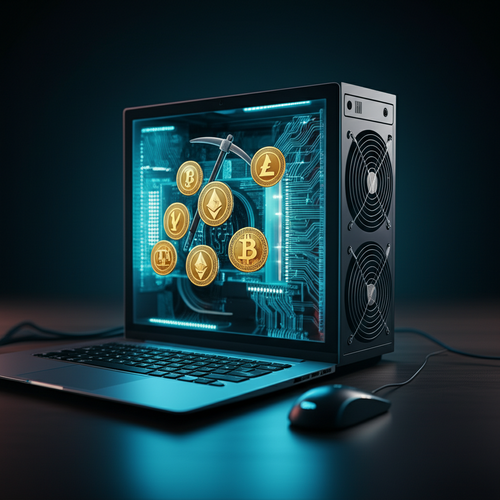Your Essential Guide to Cryptocurrency Mining: Getting Started
In the evolving digital landscape, cryptocurrency mining stands as a foundational pillar, enabling the decentralized and secure operations of blockchain networks. Far more than just a buzzword, cryptocurrency mining is the process by which new coins are introduced into circulation and transactions are validated, playing a critical role in maintaining the integrity and security of the entire crypto ecosystem. For many, it presents an exciting opportunity to participate directly in this innovative financial revolution. Whether you’re a tech enthusiast, an investor looking to diversify, or simply curious about how digital money is created, understanding the basics of mining is your first step. This guide will walk you through the essentials, from hardware to market navigation, helping you embark on your mining journey.
Understanding Cryptocurrency Mining Basics
At its core, cryptocurrency mining involves using powerful computers to solve complex computational puzzles. These puzzles are part of the “Proof-of-Work” (PoW) consensus mechanism, which many cryptocurrencies, including Bitcoin, use to validate and add new blocks of transactions to their respective blockchains. When a miner successfully solves a puzzle, they get to add the next block of verified transactions to the blockchain and are rewarded with newly minted cryptocurrency and transaction fees.
This process serves several vital functions. Firstly, it generates new units of cryptocurrency, acting as the primary method of distribution. Secondly, it secures the network by making it computationally intensive and expensive for any single entity to control or manipulate the blockchain. The decentralized nature of mining, with participants spread across the globe, is key to preventing fraud and maintaining the trustless environment that cryptocurrencies promise.
The Role of Proof-of-Work (PoW)
Proof-of-Work is not just about solving puzzles; it’s about demonstrating effort. Each puzzle requires a significant amount of computational power to solve, but once solved, it’s easy for other network participants to verify. This asymmetry is crucial for security. The more miners there are, and the more computing power they contribute, the more secure and resilient the network becomes against attacks. This continuous competition among miners ensures that only valid transactions are recorded.
Essential Hardware for Your Mining Operation
To begin cryptocurrency mining, you’ll need specialized hardware capable of performing the intense computations required by the PoW algorithm. The choice of hardware largely depends on the specific cryptocurrency you intend to mine, as different algorithms benefit from different types of processors.
GPUs vs. ASICs: Choosing Your Rig
Traditionally, many cryptocurrencies could be mined using powerful Graphics Processing Units (GPUs), similar to those found in high-end gaming computers. GPU mining rigs are versatile and can be used to mine various cryptocurrencies, offering flexibility. However, for some cryptocurrencies, particularly Bitcoin, Application-Specific Integrated Circuits (ASICs) have become the standard. ASICs are purpose-built machines designed to mine only one specific algorithm, making them incredibly efficient but also less flexible. Businesses like Minerboxes.com often provide a range of solutions and support for setting up these specialized mining rigs, helping aspiring miners select and deploy the right equipment for their goals.
Power, Cooling, and Infrastructure
Beyond the primary mining hardware, you’ll need robust infrastructure to support your operation. Mining rigs consume significant amounts of electricity, so a stable and affordable power supply is crucial. Effective cooling systems are equally important to prevent overheating and ensure the longevity of your equipment, whether you’re using fans, air conditioning, or even liquid cooling solutions. Furthermore, a stable internet connection is essential for your mining rig to communicate with the blockchain network and receive tasks from mining pools.
Setting Up Your Mining Software and Wallet
Once your hardware is in place, the next step is to install the necessary software and set up a secure digital wallet to receive your mining rewards. This stage bridges your physical setup with the digital cryptocurrency network.
Choosing and Configuring Mining Software
Mining software acts as the interface between your hardware and the blockchain. It directs your miner’s computational power towards solving the puzzles and reports your progress to the network. Different cryptocurrencies and mining hardware require specific software. Popular choices often include EasyMiner, CGMiner, and BFGMiner, each offering various features and compatibility. Configuration typically involves entering details about your mining pool and cryptocurrency wallet address so that your rewards can be correctly attributed and sent.
Joining a Mining Pool
For most individual miners, especially those starting out, joining a mining pool is highly recommended. A mining pool is a group of miners who combine their computational resources to increase their chances of solving a block and earning rewards. When the pool successfully mines a block, the reward is split among all participants based on the amount of computational power (hash rate) they contributed. This significantly smooths out the earning process, providing more frequent, albeit smaller, payouts compared to solo mining, which can be highly sporadic.
Securing Your Cryptocurrency Wallet
A cryptocurrency wallet is where you store your digital assets. It’s crucial to set up a secure wallet before you start mining, as this is where your earned cryptocurrencies will be sent. Wallets come in various forms, including hardware wallets (physical devices), software wallets (desktop or mobile apps), and web wallets. Whichever you choose, ensure it’s reputable and that you follow best practices for security, such as using strong passwords and enabling two-factor authentication. Your wallet address is what you provide to your mining pool to receive payments.
Navigating the Crypto Market with Your Mined Assets
After successfully mining cryptocurrencies, you’ll possess digital assets that can be held, traded, or converted. Understanding how to navigate the broader cryptocurrency market is essential for managing your rewards effectively.
Understanding Market Dynamics
The value of cryptocurrencies is highly volatile and influenced by a multitude of factors, including supply and demand, technological developments, regulatory news, and broader economic trends. Staying informed about market dynamics and the specific factors affecting the coins you’re mining can help you make informed decisions about when to hold or sell your assets. Resources and insights are often shared by active communities, including platforms where firms like Minerboxes.com engage with their audience, offering updates and perspectives on the industry.
Using a Reputable Crypto Exchange
To convert your mined cryptocurrencies into fiat currency (like USD or EUR) or trade them for other digital assets, you’ll need to use a cryptocurrency exchange. Exchanges like Kraken provide platforms where users can buy, sell, and trade various cryptocurrencies. When choosing an exchange, consider factors such as security measures, supported cryptocurrencies, trading fees, and customer support. Always ensure the exchange adheres to robust security standards to protect your assets during transactions.
Future Trends and Considerations in Crypto Mining
The world of cryptocurrency mining is constantly evolving, with new technologies, environmental concerns, and regulatory landscapes shaping its future. Staying abreast of these trends is crucial for any long-term miner.
Energy Efficiency and Sustainability
One of the most significant discussions surrounding cryptocurrency mining is its energy consumption. As the industry matures, there’s a growing emphasis on more energy-efficient mining hardware and the use of renewable energy sources. Many mining operations are actively seeking locations with abundant green energy, such as hydropower or solar, to reduce their carbon footprint and operating costs. Innovations in hardware design also aim to deliver higher performance with less power consumption.
The Rise of Proof-of-Stake
While Proof-of-Work remains dominant for several major cryptocurrencies, many newer blockchain projects and even established ones (like Ethereum’s transition to Ethereum 2.0) are moving towards Proof-of-Stake (PoS) consensus mechanisms. PoS systems require validators to “stake” their cryptocurrency as collateral to validate transactions, consuming significantly less energy than PoW mining. This shift could impact the long-term viability and profitability of traditional PoW mining for certain assets, making it important for miners to diversify or adapt.
Regulatory Landscape and Geopolitics
Governments and regulatory bodies worldwide are increasingly focusing on cryptocurrency mining, particularly concerning its environmental impact and its role in financial systems. Regulations can vary widely from country to country, affecting everything from energy pricing to the legality of certain mining operations. Miners must stay informed about the regulatory environment in their jurisdiction and be prepared for potential changes that could impact their operations.
Actionable Takeaways for Aspiring Miners
Venturing into cryptocurrency mining can be a rewarding endeavor, but it requires careful planning and continuous learning. Here are some actionable takeaways to guide your journey:
- Thorough Research is Key: Before investing in hardware, research which cryptocurrencies are profitable to mine and what hardware they require. Understand the potential return on investment (ROI) versus electricity costs.
- Start Small and Scale Up: Consider starting with a modest setup to learn the ropes. As you gain experience and understand the market, you can gradually expand your mining operation.
- Prioritize Security: Always use strong, unique passwords for all your crypto accounts and wallets. Enable two-factor authentication wherever possible and be wary of phishing attempts.
- Stay Informed: The crypto market and mining technologies change rapidly. Follow reputable news sources, join mining communities, and continuously educate yourself on new developments and best practices.
- Consider Your Environmental Impact: Explore options for using renewable energy sources or participating in mining pools that prioritize sustainable practices.
Cryptocurrency mining is a dynamic field that offers a unique way to participate in the decentralized future of finance. With the right knowledge, hardware, and an informed approach, you can successfully contribute to blockchain security while potentially earning digital assets.



